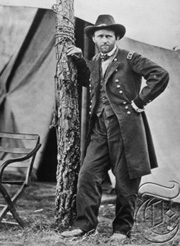 I learned something about mustangs recently from Ulysses S. Grant.
I learned something about mustangs recently from Ulysses S. Grant.
I was thinking about the Civil War, not mustangs, when I picked up Grant’s Personal Memoirs, where in the early pages, he writes about his experiences in 1846, during the Mexican American War. It was on a march from Corpus Christi, at the mouth of the Nueces River, to Matamoras near the Rio Grande, a distance of about 150 miles, that Grant’s regiment sighted an immense herd of wild horses.
“The country was a rolling prairie, and, from the higher ground, the vision was obstructed by the earth’s curvature,” Grant wrote. “As far as our eye could reach to our right, the herd extended. To the left it extended equally. There was no estimating the number of animals in it; I have no idea that they could all have been corralled in the State of Rhode Island, or Delaware, at one time. If they had been, they would have been so thick that the pasturage would have given out the first day.”
At the time, according to Grant, it was common for Mexicans to roundup large numbers of the horses and sell them to American settlers, who in turn would sell them to the army. While prices ranged from $8 to $12 for a “picked” animal, at wholesale, a dozen could be purchased for $36. In fact, on the day that he saw the great herd, Grant was riding a horse that had been a member of it just a few weeks earlier — a 3-year-old colt purchased for $3.
“The day we started was the first time the horse had ever been under saddle,” Grant related. “I had, however, but little difficulty in breaking him, though for the first day there were frequent disagreements between us as to which way we should go, and sometimes whether we should go at all. At no time during the day could I choose exactly the part of the column I would march with; but after that, I had as tractable a horse as any with the army, and there was none that stood the trip better. He never ate a mouthful of food on the journey except the grass he could pick within the length of his picket rope.”
Grant, who excelled at horsemanship at West Point, was impressed by the type and stamina of the wild horses.
“The horses were generally very strong, formed much like the Norman horse, and with very heavy manes and tails,” he noted. “A number of officers supplied themselves with these, and they generally rendered as useful service as the northern animal; in fact they were much better when grazing was the only means of supplying forage.”
The “Norman horse” mentioned by Grant refers to a type of horse bred for centuries near La Perche, a district of Normandy, in Northern France. These were the warhorses ridden by Norman cavalrymen to defeat the Anglo-Saxons at the Battle of Hastings in 1066, and whose descendants came to be called Percherons, for their place of origin.
Today, Percherons are classified as draft horses, but they also carry Arabian (or “Oriental”) and Andalusian blood going back as early as the eighth century and as late as the nineteenth century.
Percherons were first imported to the United States in 1839, by Edward Harris of Moorestown, New Jersey. Two stallions, Normandy and Louis Napoleon, were imported to Ohio in 1851, and Louis Napoleon was later sold to the Dunham family in Illinois, who became instrumental in forming the Percheron Association of America.
A relatively new breed called the Spanish-Norman Horse, has been developed to re-create the phenotype of the Norman warhorse. While many of the European warmblood breeds, which excel in dressage and show jumping, have Anglo-Norman ancestors.
Although original mustangs of the Southwest are believed to have been descendants of imported Spanish horses, there is evidence that some were descended from Norman and Breton horses sent to America by King Louis IV of France, in the late 1600s. The Canadian Horse or Cheval Canadian has developed from these same roots.
